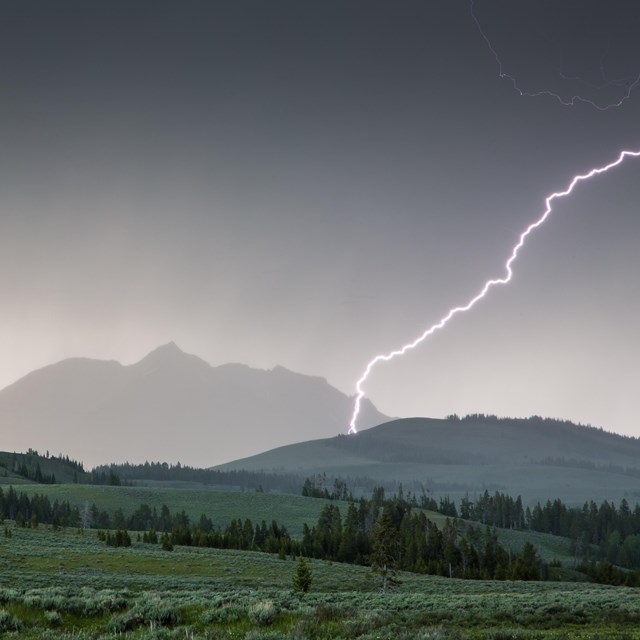
Whether you're looking for a guided horseback tour or planning to explore with your own stock, Yellowstone offers a variety of ways to experience its backcountry on horseback. All stock users must follow park regulations, including those related to weed prevention, disease control, and trail etiquette. Choose well-trained animals familiar with your handling methods, bring only as many animals (horses, burros, mules, or llamas only) as necessary, keep stock under control when passing others, and be courteous to fellow trail users. 
Exotic PlantsNonnative, invasive plants are spreading rapidly in Yellowstone—threatening native ecosystems and wildlife. Nearly 200 nonnative plant species have been identified in the park, with aggressive invaders such as spotted knapweed, oxeye daisy, yellow and dalmatian toadflax, St. Johnswort, and leafy spurge posing the most serious threats. Prevention & ControlInvasive plant seeds spread easily via dirty vehicles, disturbed roadsides and trails, and contaminated hay or straw—often reaching deep into the backcountry. Help stop the spread of invasive plants by following these simple steps:
Coggins TestTo prevent the spread of equine infectious anemia, ALL stock animals (horses, burros, and mules) entering Yellowstone, even if you are driving through without stopping, must have proof of a negative Coggins test within the past 12 months. You must carry proof of a negative Coggins test for each animal at all times. Photocopies are acceptable in the backcountry. Documentation must include:

Courtesy / Sherrie & Ron White Day Rides & Overnight UseBefore day riding in Yellowstone, private stock users must obtain a free day ride permit. Only one permit is needed per group per day, but a separate permit is required for each day. Group size is limited to 20 people and 20 stock animals, but there are no limits on the number of permits issued for a given area.Overnight stock use is not permitted before July 1 due to trail conditions and range readiness. A backcountry permit is required for all overnight trips and must be obtained before entering the backcountry. Each backcountry campsite has a limit on the number of people and stock allowed, so reserve campsites in advance for overnight stock trips. Some sites do not allow stock, so use the backcountry trail map to check individual campsite details, including stock limits. At The TrailheadPlease park in a way that doesn’t block others—trailheads can get busy during the summer. Manure at the trailhead must be removed. Keep stock off roadways, except at designated trail crossings. All feed must be processed to eliminate weeds and weed seeds. Securely wrapped, certified weed-free hay is allowed in the frontcountry but no hay is allowed in the backcountry. Horses and other stock may not be kept overnight at trailheads or front-country campgrounds in the park. For a list of campgrounds outside the park that allow overnight stock stays, contact the Central Backcountry Office. On The TrailWhen riding in Yellowstone, always travel in single file on established trails, avoiding shortcuts or cutting switchbacks. Pack strings must stay on designated trails. All pack stock must be led—free trailing or loose herding is prohibited. Exercise caution when approaching other parties on the trail. Anticipate problems and have your animals under control. If backpackers seem unsure of what to do, courteously offer instructions to permit safe passage.In CampWhen managing stock, use retention methods (hobbles, pickets, electric fences) that prevent resource damage. Select grazing areas at least 100 feet from streams, trails, and campsites, and rotate grazing sites to avoid overgrazing. Keep stock in the core camp area only for packing or unpacking, and remove all manure from the core camp. In grazing areas, scatter manure to help it break down and reduce parasites.No permanent structures, including corrals, are allowed. Tying stock to trees or highlines is permitted for short periods, but avoid damage by using tree saver straps and ensuring trees are at least six inches in diameter. Only dead and down wood may be used for picket pins, and any pins should be removed before leaving. Do not leave stock unaccompanied in camp for long periods. If there are no current fire restrictions and fires are allowed in your site, only use wrist-sized dead and down wood and the established fire ring; creating new ones is prohibited. Extinguish your campfire thoroughly and pack out all trash, including foil and glass. Stock Prohibitions
Bear Safety
More Information
|
Last updated: July 2, 2025






